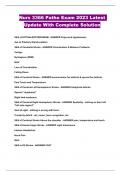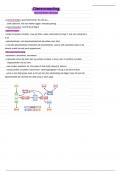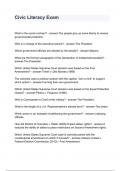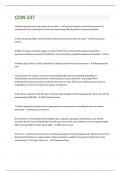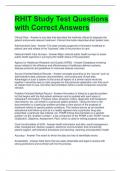Lesson 1 – Chapter 1 + 2 + Appendix C2 and S&OP (Manufacturing)
Difference ERP and APS:
- ERP = transactional system
- Based on MRP-II (Material Requirement Planning)
Work loading:
- Infinite loading = ignores capacity constraints, only helps to
identify bottlenecks
- Finite loading = allows only as much work to be assigned as
can be done with available capacity
APS is:
- Decision making Computer based
- Allocation Activities to be done on limited resources
- Business Processes Manufacturing & service industries
o Procurement, production, transportation, distribution
- Complex Mathematical techniques & heuristics
1
,Decision making Hierarchy:
Why is planning done hierarchically:
- Certain decisions must be made earlier
o It takes a few years to build a new plant
o It takes several months to hire new people or build new silos
Exactly what SKU, color, machine, person, sequence on a machine
can be decided later
- Decisions made a higher level determine constraints at lower level
o More constraints on shorter horizon that are the result of earlier decisions
- Uncertainty increases over time
o Range of possible outcomes is larger on longer term
- Aggregated forecasts are usually better
o Longer term forecasts over at family level are more accurate than at SKU
level
- Complexity
o Aggregation is needed at higher level to reduce complexity
S&OP process Different, level different structure &logic
Volume planning = a planning level that does not ‘know’ about orders and which plans
volumes of demand in periods, based on an aggregate resource mode
Order planning = this is the level “where the order comes,” and here the order is
accepted and planned, based on the S&OP plan, more detailed capacity limitations,
and available material on an aggregate level.
Scheduling = this is the level where individual resources or employees are
selected and assigned. In other words, it is where the “what” of the levels above
is translated in a “how” to produce as efficiently as possible
2
, Difference planning & scheduling:
Planning Scheduling
Buckets Bucketless (continuous time)
No sequence Sequencing
No complex constraints, setup times Complex constraints and setup times
Aggregated (families, resource groups) Detailed (SKU, machine/person)
Terminology
- Resource = ‘machine’
Gantt Chart
- Task = ‘job’
- Job > 1 operations
Product-process matrix
Overview of manufacturing models
Project scheduling Job shop scheduling Lost scheduling
-Precedence constraints -Multiple operations, -Continuous productions
-Typical ojective, minimize different routes -Switching between
makespan -Minimize makespan, products incurs setup cot
-Critical jobs number of late jobs -Minimize total inventory &
-Construction/building -Single machine, parallel setup costs
industry, ERP machines, flow shop -Process industry
implementation - Customized industrial
hardware, hospitals
Statistic data:
Processing time (pij) = represents the time job j has to spend on machine i
Release date (rj) = the time the job arrives at the system i.e. the earliest time at
which job j can start its processing
Due date (dj) = represents the committed shipping or completion date
Weight (wj) = priority factor, reflecting the importance of job j in the system for one
time unit
3



